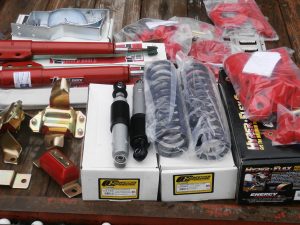Editor’s Note: Back in February we posted Part One of Dr. John O’Connor’s story about his latest race car, a 1995 Mustang GTS that will compete in NHRA Super Street.
In this installment, Dr. John gives you an overview on getting sponsorship for a car—what to do, what not to do, and what a sponsor expects from a racer.

This is what a race car looks like if you don’t have the money to go racing. Below are tips for getting sponsorship so you don’t have to sit in the stands.
When you go racing on your own dime, you have full control of your project. It can also mean not having enough money to buy the parts you need, or to race a full season.
This is why most people look to sponsorship to help them finance their race team. Sponsorship can give you access to parts (and often better-quality parts) and help defray the travel and other costs associated with racing.
Getting sponsorship isn’t easy. It can take a long time to get financial backing for an entire racing season. Here are some things I learned as I went looking for sponsorship for my team.
Be Realistic
Trying to build the car on a budget and stay competitive is challenging. You will need the best parts you can afford, be able to replace parts as needed during the season, and have funds to travel to other tracks if necessary. That means you have to be realistic about what class you compete in. Sponsors are more likely to support a racer that has obtainable goals, not starry-eyed dreams.
That’s what I had to do when I started thinking about going racing. I really wanted to compete in NHRA Super Stock, one of my favorite classes. It’s a tough class with cars that run nine-second ETs, but I thought I could build something competitive on a budget.
Then I noticed the factory-built Dodge Challenger Drag Pack cars were cleaning up in Super Stock. I don’t know about you, but I can’t afford a Drag Pack Challenger, and quickly realized I couldn’t afford to build a car that would be competitive without a second mortgage.
It was time for a reset. I decided that to be competitive and live within my budget, I would compete in the Super Street category which features cars running a 10.90 index. It was more realistic to build our Mustang for that level of racing, and would make sponsorship easier to obtain as our parts requirements would be less demanding.
Finding Sponsors
Finding race sponsorship has challenges. The economy might be on the rebound, but it’s still a tight market. Even top racers such as NHRA Top Fuel’s Alan Johnson have not been able to find sponsorship.
I have been trying for about a year to find the full sponsor for our team. We had a few nibbles, but no bites. Sponsorship funds for drag racing on the local or sportsman level are few and far between. To ensure funding, race teams usually lock in their sponsors so those companies cannot fund other teams, even in noncompeting types of racing. For instance, if a team has a NASCAR sponsor, that sponsor would not be allowed to sponsor a drag racing team.
For those reasons, we contacted racing manufacturers for parts sponsorship. That works very well on the sportsman level because companies get exposure for their products without a big financial commitment. Donated parts free up some of your budget for other uses.
A sponsor looks for several things in a race team. A winning record helps, of course. But whether you’re a veteran or new to racing, there things you absolutely must do:
- Show a sponsor what you will do for them. Show a sponsor where you will be racing and how often you’ll be competing. Tell them where you will place their decals on the car and trailer. Offer to talk to racers about the company’s parts and pass out literature. You want to give that sponsor as much promotional value for their parts donation as possible.
- Be professional. Submit a polished proposal package, not some scribbled notes or a hurried e-mail. If you need professional help to do that, get it. Make sure you and your team look and act the part. You don’t need expensive matching uniforms, but you do need a neat, clean-looking crew, car, and trailer.
- Stay up to date. By that, I mean keeping your sponsors in the loop on race results and any promotional things you have done for them. If you have a presence on social media—Facebook, Twitter, etc.—keep posts current. Too many racers don’t update social media regularly, which makes you and your sponsors look bad.
Keep your attitude positive and professional as well. Racing is supposed to be fun, but you have to show you are serious about competing to win.
A word of warning—don’t promise to do something and then not do it. That’s the quickest way to lose a sponsor. And believe me, the racing parts world is small and word will get around that you don’t deliver.
It’s rare, but sometimes companies agree to help, but back out at the last minute. That has happened to us. Be prepared for this situation by having a list of potential sponsors you can talk to. In a couple of instances, we were able to replace a sponsor with another who agreed to send us Mustang parts.
Think Outside the Parts Box

Dr. John’s persistence paid off, getting several manufacturers to provide parts for the Red Dragon Racing Mustang. We’ll be outlining the Mustang’s chassis upgrades in the next installment of Working Man’s Race Car.
A race team needs other things besides parts—tools, fuel, oil, cleaning supplies, and so forth. Those are good areas to look for sponsors, especially on a local level. For example, I needed access to a lift to work on the Mustang. We don’t have one in our garage, and can only lift the car up about 20 inches with jackstands. Fortunately, we were able to make arrangements with Central Auto in Pennington Gap, VA. They are the Ford experts in our community and race a seven-second 1993 Mustang. Central Auto gave us access to the lower facility in the shop on the weekends. It definitely saved me the thousands of dollars it would have cost to install a lift in my garage. You have to be creative to solve problems.
What’s Next
In Part Three of Working Man’s Race Car, we’ll outline the chassis and suspension plan for the Mustang. Think eight-point roll cage, tubular K-member and suspension bits, rear coil-overs, the whole nine—er, 10.90 yards.

My take on Sponsorship , you must ask yourself this ;
“Does anyone give a crap about your ideas, goals,what you represent or have to say ? ”
As to approval by others via contribution, your car shouldn’t be built on it.
Was there a part three written?
My brother has been planning to join a drag race next year, and he’s currently building his car for the drag race. He needs a new transmission and clutch components. We’ll keep in mind to build a car on a budget and find the best parts at an affordable price.